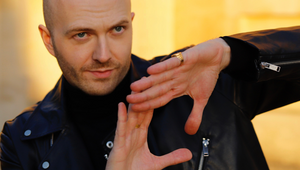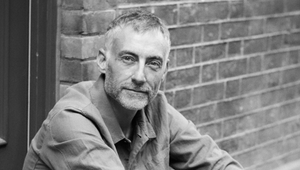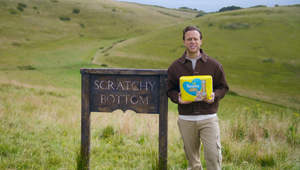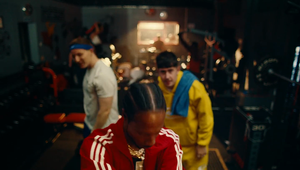
How Anders Hallberg Explored the Contrasts of Caregiving through a Cinematic Lens

‘Love Doesn’t Take a Break’ is a heartfelt ‘thank you’ to all the unpaid caregivers whose work is so essential yet often goes completely unnoticed. Directed by Great Guns’ Anders Hallberg, in collaboration with Teva Pharmaceuticals and VCCP Health, the film sets out to depict the contrasting emotions involved in taking care of a loved one, and to make all the carers feel less alone in what they’re doing.
Anders’s work here walks a delicate line between authenticity and stylisation. A high contrast colour scheme creates a sense of intimacy while Anders also used Anamorphic lenses to stay within the realm of realism while simultaneously helping to add a stylised feel. Additionally, he opted for a SnorriCam rig (worn by the actress) to get even closer to the protagonist during the moment when she collapses from exhaustion to make the viewer feel like they’re in the room with her. The intense, tender one minute spot was the result of 165 edits with everyone collaborating closely to get the look and the message of the final film right. The emotive voice over narrative, in place of traditional dialogue, was Anders’ own idea which the client liked; thanks to Great Guns’ CEO Laura Gregory powers of persuasion, the legendary actor John Rhys-Davies lent his voice to the film - himself once a caregiver to his wife who had Alzheimer’s disease.
Today, Anders tells LBB about why working on what was clearly a “passion project” for everyone involved meant more creative freedom and visual experimentation, the close collaboration that went into the making of the film, and why the “intense process” was necessary to get to the truth of the story while staying away from emotionally exploitative cliches.
LBB> Tell us a little bit about the original brief and what your initial thoughts on it were?
Anders> When I first got the script I was immediately drawn to how emotional it was. The fact that it didn’t have an actual product to sell or promote was also very intriguing. It started off as a sound driven spot where all the scenes were connected top and tail through a transition that was triggered by sound. Soon enough we realised that the technical aspect of that might take away from the film emotionally as we needed it to truly engage the viewer on a deeper personal level. We kept a lot of the transitional ideas as a tool to quickly go from one part of your daily life to another, but without taking away the focus from the people.
LBB> How much creative freedom did you have to execute the brief?
Anders> A lot but in the most collaborative of ways. We had numerous calls together with the creative team to discuss how we could improve the film from an emotional perspective and shared lots of interesting and personal anecdotes from our own lives and from extended family and friends’ lives. We soon realised that there was so much more to this than “just” another campaign film as it was such an important message – a sort of thank-you film for the often forgotten caregivers who play such an important role. The health system would most likely collapse without the unpaid work by caregivers that happens at home during any given day and hour of the year. It was very clear that this film would continue to be a creative process until it went on air.
My experience is that these days the world of advertising is often dictated by numerous tests and anxious clients relying on recent Google seminars about certain points one should hit at certain specific times during a film. This campaign however was the opposite – a passion project from the client, the agency and all of us who were part of this creative journey without any creative limitations or pre-determined advertising formulas.
LBB> What did you, Teva Pharmaceuticals and VCCP Health want to achieve and communicate with the spot?
Anders> Quite simply to acknowledge and put the spotlight on all the people doing the hard work as caregivers and to show them that they are not alone. There are so many people out there sharing the tasks of helping a loved one.
LBB> ‘Love doesn't take a break’ is a highly emotive spot that depicts the difficulty, tenderness and joy of caring for a loved one. With a beautiful high contrast colour scheme, it looks very stylised. How did you balance the idea of authenticity and the cinematic feel of the final spot?
Anders> I’m glad you noticed. As a director/DP, I always try to find inspiration from the real world in the sense that I don’t ever want anything to feel lit or overly stylised. Many times in advertising, we see our heroes being lit which to me immediately puts me in a world of advertising. I try to focus on lighting the space itself and letting the people play out their parts within the space that we carefully curate with the help of lighting and art direction. For this specific project I decided at an early stage to go for anamorphic lenses since it would allow me to stay even more realistic, if you like, while still pursuing a more cinematic way of telling the story. We also opted for some exciting rigs for the camera to allow the viewer to feel even closer to our caregiver. In the short montage where she almost collapses from all the pressure where I used a SnorriCam rig that allowed for the camera itself to be strapped onto her body in order to literally follow her every move.
LBB> The spot is only a minute long but packs in a lot of emotions. How does the running time impact how you told the story?
Anders> It always plays a part, but for the last few years we’ve gotten so used to telling a story in 15 seconds and even six seconds that having a minute feels like an epic version of what we usually get to explore. We did allow for a long editorial process in order to have a very collaborative back and forth with the agency and client. Believe it or not, but we ended up with a total of 165 different edits before we were all happy. That does include an even longer two minute piece and a couple of different shorter versions too. But it was an intense process and a big opportunity to explore many ways of telling this story to best stay true to something that feels real and wasn’t just exploiting the footage with cheap ways of harvesting the teary-eyed moments.
LBB> The narrative is told through the voiceover, with no dialogue between the characters. How did this affect your direction?
Anders> It wasn’t meant to be like this originally, and I remember having a conversation with the agency and client on the shoot about possibly exploring a VO to narrate it which they thought sounded interesting. I played around with this further in the edit and found a beautiful poem with an older man speaking back from the other side to his beloved. This however was pushing it a little too far for the client, to have the VO of someone who’s already deceased, so the agency wrote this beautiful piece of VO that we went back and forth with a few times. Then we managed to get John Rhys-Davies involved after Laura Gregory (founder and CEO of Great Guns) reached out to him personally and explained the job in detail, which truly resonated on a deeper level with him, as he himself had been a caregiver to his wife.
LBB> Tell us about the process of shooting - how long did it take and did you run into challenges?
Anders> We shot over two, unusually cold, days in and around London and as always we had a very ambitious shooting schedule. The entire crew showed such dedication and passion. It was a true joy to see how much we can actually achieve together when we work towards something that, I think, felt like an important story for all of us to tell.
LBB> What was your favourite part of working on the spot?
Anders> I have to say the collaboration – turning over every stone in order to explore all possible creative ways to create this little mini film. Everyone working together from the fantastic and very involved client, to the whole team at VCCP Health. I have to give extra credit to Brett O’Connor who was always making himself available and who managed to create a working environment that was totally unfiltered and truly creative.















